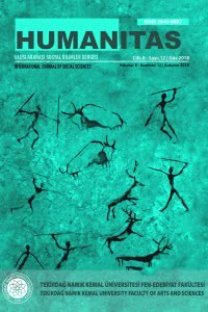270 YAYIN DEĞERLENDİRME / REVIEW
Golban P. (2013). The Foundations of English Literary Criticism: FromPhilip Sidney to Henry James (Lewiston USA, Queenston Canada,Lampeter United Kingdom: The Edwin Mellen Press Ltd. 480 pp. ISBN-13: 978-0-7734-4508-6, ISBN-10: 0-7734-4508-0)
Anahtar Kelimeler:
-
-
It is then only normal to assume that this task is better achieved by focusing on writer-critics. They are the practitioners who speak theory, the creators of both imaginative and critical writing. They are the key-figures in this study tracing the development of British criticism both as a unique national experience and within the larger context of the Western critical tradition. The major British writer-critics are Philip Sidney, Ben Jonson, John Dryden, Alexander Pope, Samuel Johnson, Henry Fielding, William Wordsworth, Samuel Taylor Coleridge, Percy Bysshe Shelley, Matthew Arnold, Walter Pater, John Ruskin, Henry James, Virginia Woolf, T. S. Eliot, and others. Their critical texts are placed in the context of their time, since they represent the most important periods and experiences of the English critical history, including the Renaissance, Restoration, neoclassicism, the rise of the novel, Romanticism and the Victorian age. With a few exceptions like T. S. Eliot, who is to the present day acclaimed as both writer and critic, or Pater, who is nowadays remembered mainly as a critic not a writer, the literary history has proven that in the case of writer-critics their literary voice attracts a wider audience and is more persistent in time than their critical one. Literary work possesses eternal temporal validity due to its autonomous aesthetic value, whereas criticism provides points of view having temporary and transitory significance. As both literary and critical discourses reveal a tendency to remain eternal in time, the present book attempts to eradicate the discrepancy of value between the two hypostases (which represent at once the two voices of writer and critic) of one literary personality, so as to restore the longevity of the writer-critics whose critical voices were once listened to and acclaimed by the audience but have continued to be appreciated to the present day mainly only as literary voices. In order to grasp properly the historical order of events, the examination of criticism in this book starts with the period and its theories, literary and critical trends, and literary genres, and continues with the writer-critic and the critical text in general. The core period covered begins with the Renaissance and ends with the Victorian Age, but proceeding it is another section dealing with ancient and medieval criticism. Also, clear connections are made with the twentieth century tradition, especially the critical theories of the Formalists, New Criticism, Cambridge English School, T. S. Eliot, Virginia Woolf, Percy Lubbock, E. M. Forster, and others. This volume is closely interrelated with the book entitled Texts Analyzing Literature as Argument: From Philip Sidney to Henry James, which may be taken as an appendix and which covers the same periods and focuses on the same writer-critics. However, the books may be read independently and not necessarily in any order. The Foundations of English Literary Criticism is a monograph of the intellectual history, whereas Texts Analyzing Literature as
Keywords:
-,
- ISSN: 2147-088X
- Yayın Aralığı: Yılda 2 Sayı
- Başlangıç: 2013
- Yayıncı: Namık Kemal Üniversitesi
Sayıdaki Diğer Makaleler
ÖDÜLLÜ PEYZAJ FOTOĞRAFLARINA ANALİTİK BİR YAKLAŞIM
Esra ÖZHANCI, Hasan YILMAZ, Hanifi TEKİN
KARŞILAŞTIRMALI EDEBİYAT VE MİTOLOJİ İLİŞKİSİ
Humanitas SOSYAL BİLİMLER DERGİSİ
PRODUCTIVITY OF THE SUFFIX –ER IN ENGLISH AND GERMAN
20. YÜZYILIN BAŞINDA TÜRK AYDINLARININ JAPONYA’YA BAKIŞI VE “MUSAVVER JAPON ÇOCUKLARI” KİTABI
ORTAÖĞRETİM ÖĞRENCİLERİNİN KENTSEL TURİZM ALGILARININ DEĞERLENDİRİLMESİ: EDİRNE İLİ ÖRNEĞİ
ÇEVRE VE EKOLOJİ KAVRAMLARININ EKOELEŞTİREL VE KAPİTALİST SÖYLEM BAĞLAMINDA İNCELENMESİ
